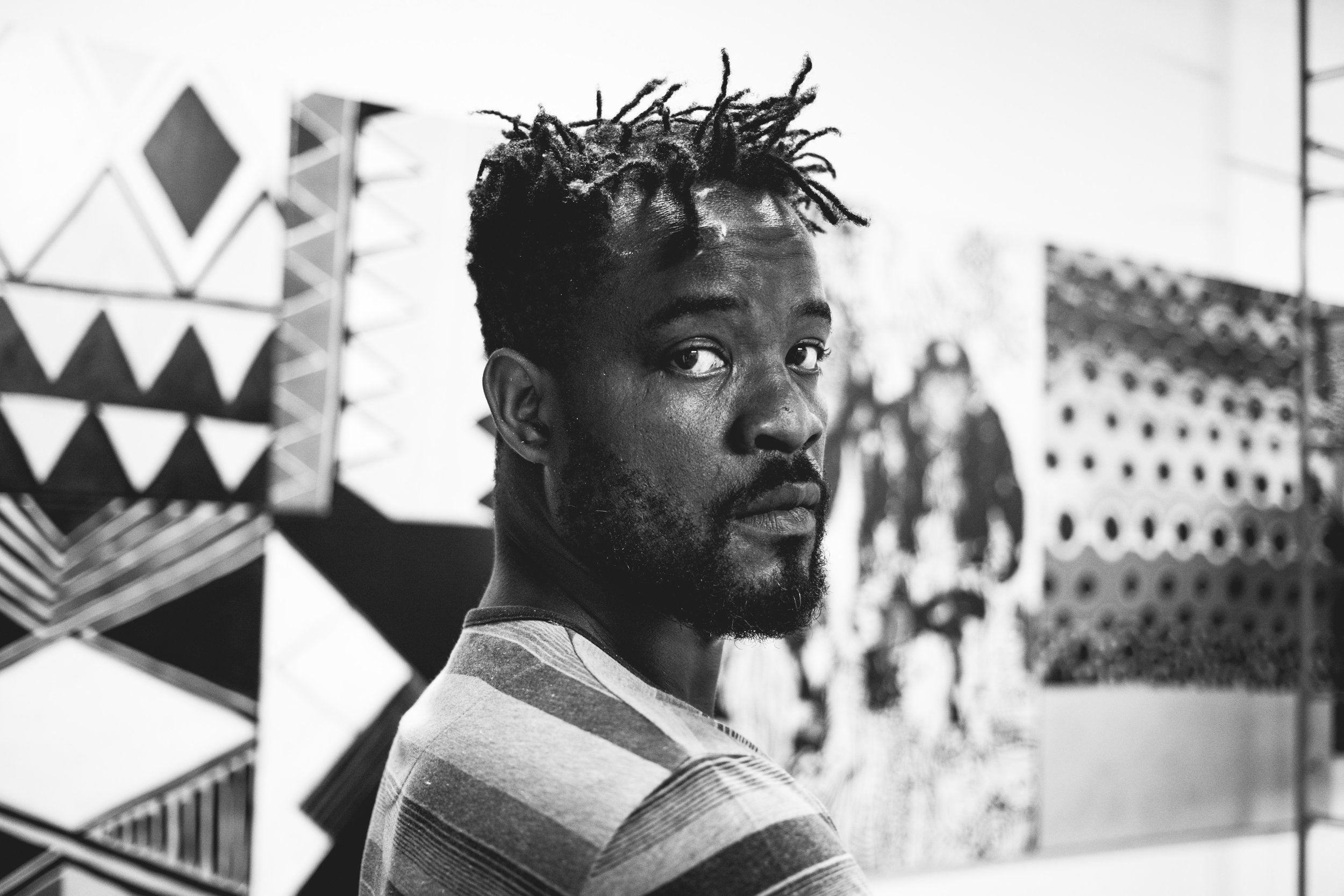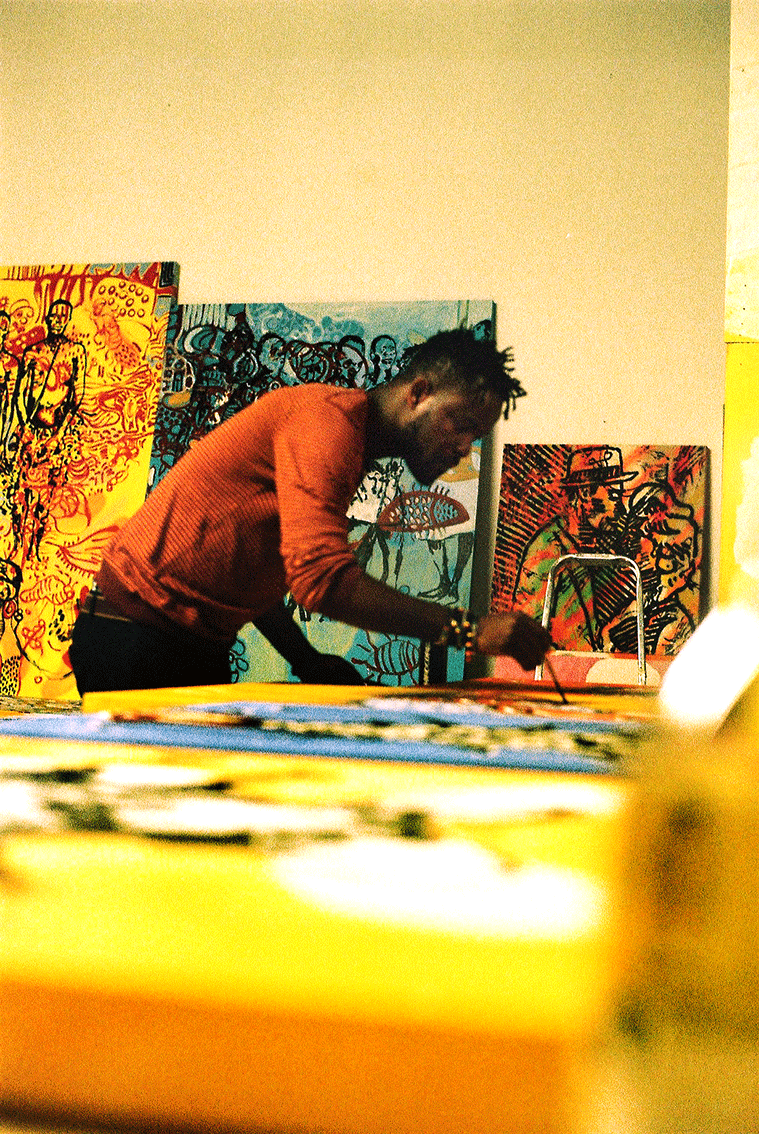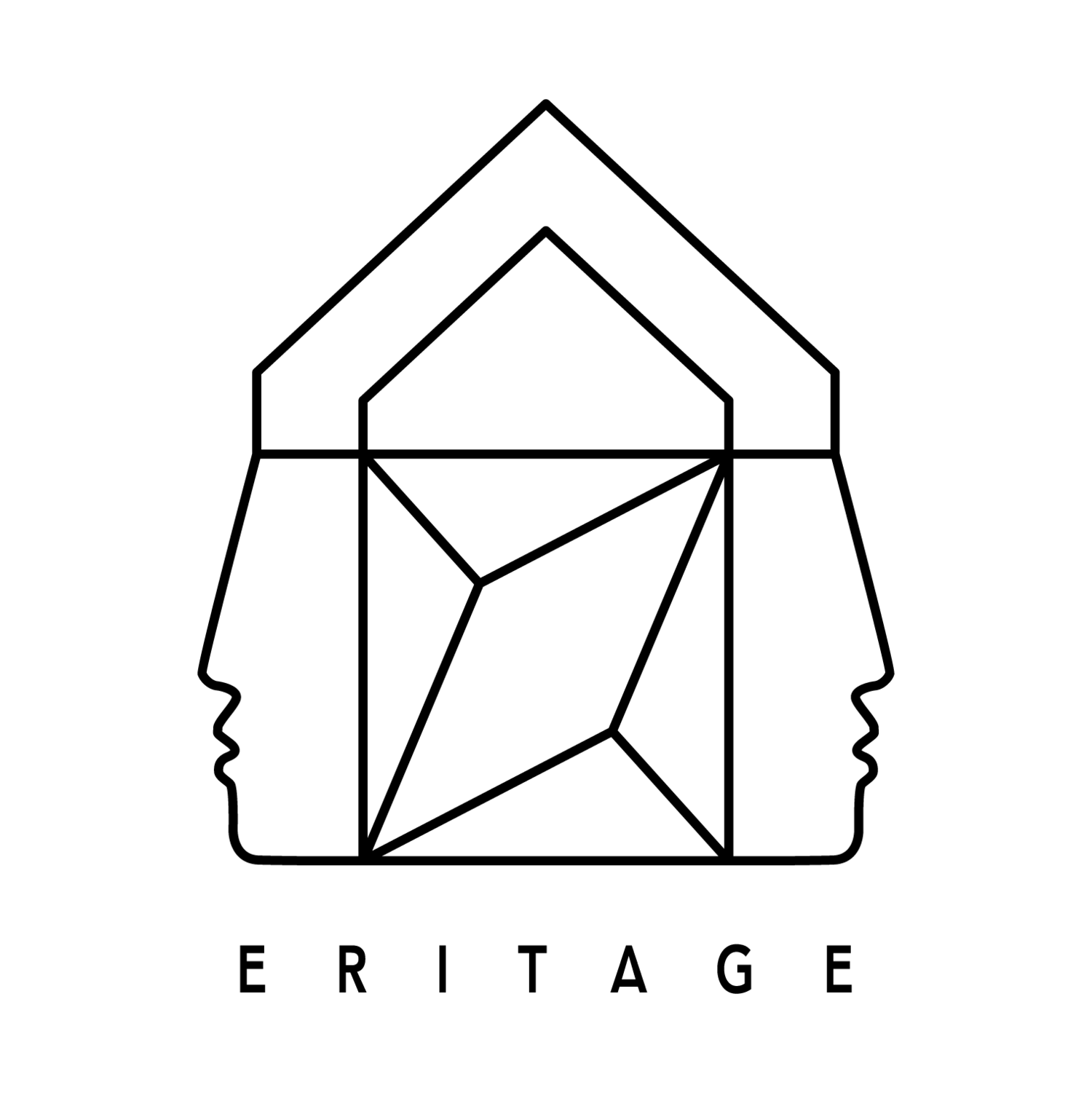
ABR 17 | Territórios - Reino Angolar Utopias e Territórios
O projeto Territórios consiste em duas exibições individuais simultâneas, de dois dos principais artistas contemporâneos emergentes africanos da atualidade: Kwame Sousa, de São Tomé e Príncipe, que apresenta o projeto Reino Angolar: Utopias e Territórios, e Francisco Vidal, português, angolano e cabo verdiano, com seu projeto Utopia Luanda Machine, Territórios é fruto da residência conjunta iniciada em Fevereiro 2017 no espaço atelier da Wozen.
Kwame Sousa
Telegraficamente Amador! Olhos e mentes motoras de todas as utopias, Kwame Sousa entra na teia de sonhos e mistérios, caminha lado a lado com os demais artistas, enfrenta cruzamentos de linhas mas não descarrila. E agora aceita Anguéné, terra angolar, revisita seu território grávido de magia e imaginários férteis paridos nas camas do ventos do sul. E entra no óbó dançando congos. Reinterpreta escrevedores: Francisco Tenreiro, Alda do E.Santo, Almada Negreiros, São de Deus Lima e outros que também são de Deus.
Com os cavalos transportadores de outras dores, nos rostos dos carregadores de esperança. Cuidados com as cruzes ameaçadoras de outros tempos, no budo-bachana que não se vê, nem angras nem lulas, nem pau-sangue, nem mesmo quem votou feitiçaria.
Tudo isso são sete navalhas de pedra. Esculpidas e repartidas sob o olhar do capitão dos Angolares, guião, chefe, juiz e soldado, como diz Macedo. Nem é tarde nem é cedo. É agora. Anguéné escreve: “e puxando, assim a alma do destino desse povo estranho, reis fantásticos e heróis lendários, feitiçarias, rituais, empolgamentos de amor e magias”.
Assim Seja!
Não basta ser.
É preciso ANGOLAR! - João Carlos Silva
Nascido em São Tomé e Príncipe, em 1980, Kwame é um artista verdadeiramente multidisciplinar, explorando uma enorme gama de mídias, técnicas e estilos. Integrou a II Bienal de Arte de São Tomé e Príncipe (2002), e no mesmo ano expôs no Instituto Politécnico do Porto. Iniciou sua carreira acadêmica em 2004 passou pela EPAOE e em seguida pela AR.CO - Escolha de Arte Independente. Nos anos seguintes, Kwame participou de exposições individuais e colectivas em diversos países, com seu trabalho integrando diversas coleções privadas.
Recentemente, participou da Bienal de Arquitectura de Veneza (2014), do Festival de Cinema de Lisboa (2014) e expôs no Museu de Portimão (2016). Kwame pertence à terceira geração de artistas do seu país, sendo considerado um dos artistas contemporâneos mais influentes de São Tomé.
...
The project Territórios consists in two simultaneous exhibitions, from two of the most important emerging african contemporary artists: Kwame Sousa, from São Tomé e Príncipe, presenting the project Reino Angolar: Utopias e Territórios; and Francisco Vidal, portuguese, angolan and cape verdean, with his project Utopia Luanda Machine. Territórios is the ongoing result of the joint residency initiated in February 2017, inside Wozen Studio`s working space.
São Tomé e Príncipe are two islands located in the Gulf of Guinea where latitude and longitude are close to zero degrees. The islands where discovered by the Europeans in the late fifteenth century. It remains nuclear whether the islands were inhabited at their time of Discovery. But shortly after their Discovery they were populated with people brought by force from mainland Africa, first to work as slaves in the sugar plantations and later on to be transported to the Americas.
In July 1595, a slave named Amador led a revolt against the Portuguese colonists. After some initial successes, the revolt failed and in August 1595 Amador was captured and killed. The economy of São Tomé e Príncipe had however been devastated and many colonists went to Brazil, to establish sugar plantations over there. In 1598, the Dutch started their attacks against the Portuguese that stayed on the islands, leading to to further destruction of the islands economy.
São João dos Angolares is a town on the east coast of São Tomé island. The people speak Angolar, a unique creole language. It is a nuclear how they arrived on the island. Legend has it that Amador was king of the Angolares people and that he led them to revolt. The Angolares community is still very distinct from the other communities on the islands and continues to have its own traditions and world views.
Kwame Sousa spent a couple of months in São João dos Angolares annd tried throught his art to discover the realm that was left by King Amador. It is a realm that exists in people’s minds and is shrouded in mystery, with little or no written resources, and whose existence is regularly challenged by researchers who require empirical evidence. Kwame’s process of Discovery is reflected in the exhibition.
Kwame Sousa was born in April 1980 in the Agostinho Neto plantation on São Tomé islands. He discovered his taste for art during his secondary school and started to draw as an autodidact. He became in 2001 on of the winners of the experimental Project O.I, which resulted in an exhibition of his Works in the Teia de Arte gallery in São Tomé.
In 2002 Kwame attended various workshops in the Teia de Arte gallery hosted by artists from different parts of the world. This allowed him to link and exchange experiences in different artistic languages. In the same year, he participated in the second biennale of São Tomé e Príncipe and joined an exhibition at the Polytechnic Institute in Porto (Portugal). This was followed by various solo and joint exhibitions in São Tomé and various other countries.
Kwame commenced in 2004 his academic career in Portugal, starting at EPOA, the School for Performance Arts and Craft, and followed by AR.CO, the School for Independent Art where he studied drawing and painting. In 2014 he participated in the Architecture Biennale in Venice and at the Lisbon Cinema Festival with the vídeo “Moinga House” a joint Project with the plastic artists René Tavares (also from São Tomé e Príncipe).
At this moment, he collaborates with the CACAU (House of Arts, Creation, Environment and Utopias) project in São Tomé e Príncipe, with the ZERO Point gallery in Mindelo, Cabo Verde, with the ROÇAMUNDO foundation in São Tomé e Príncipe and BUALA, portal for contemporary art.
With exhibitions in different galleries all over the world and having participated in various editions of the São Tomé e Príncipe Biennale, Kwame Sousa belongs to the third generation of artists of his country, being considered one of the most influential plastic artists of São Tomé e Príncipe.

behind the scenes | photo: Lucca Miranda

Kwame Sousa behind the scenes | photo: Lucca Miranda

behind the scenes | photo: Lucca Miranda


utopias and inspirations...

Wozen team setting up | photo: Lucca Miranda



vernissage night | photo: Lucca Miranda


Don't Have Slaves, 2017 - 200 x 157 cm | óleo sobre tela / oil on canvas

God Fish I, 2017 | 92 x 86 cm - óleo sobre tela / oil on canvas

God Fish II, 2017 | 92 x 86 cm - óleo sobre tela / oil on canvas

God Fish III, 2017 | 92 x 86 cm - óleo sobre tela / oil on canvas


Kwame Sousa | photo: Lucca Miranda

Angolar Social, 2017 | 217 x 253 cm - óleo sobre papel antigo / oil on antique paper

Angolar Woman, 2017 | 110 x 92 cm - óleo sobre tela / oil on canvas

I don't wanna be like everybody; I'm Angolar, 2017
180 x 146 cm / óleo sobre tela

"Untitled", 2017 - 77 x 80 cm | óleo sobre tela / oil on canvas
"Dead Nature IV", 2017 - 80 x 78 cm | óleo sobre tela / oil on canvas
"Dead Nature III", 2017 - 42 x 61 cm | óleo sobre tela / oil on canvas
"Rei Amador II", 2017 - 110 x 91 cm | óleo sobre tela / oil on canvas
"Dead Nature II", 2017 - 92 x 86 cm | óleo sobre tela / oil on canvas

"Untitled", 2017 - 78 x 80 cm | óleo sobre tela / oil on canvas
"Dead Nature VII", 2017 - 80 x 78 cm | óleo sobre tela / oil on canvas
"Dead Nature VI", 2017 - 42 x 61 cm | óleo sobre tela / oil on canvas
"Dead Nature V", 2017 - 80 x 78 cm | óleo sobre tela / oil on canvas
"Untitled", 2017 - 78 x 80 cm | óleo sobre tela / oil on canvas

"Dead Nature XI", 2017 - 92 x 86 cm | óleo sobre tela / oil on canvas
"Dead Nature IX", 2017 - 92 x 86 cm | óleo sobre tela / oil on canvas
"Dead Nature X", 2017 - 92 x 86 cm | óleo sobre tela / oil on canvas
"Dead Nature VIII", 2017 - 92 x 86 cm | óleo sobre tela / oil on canvas

"Friends", 2017 - 180 x 147 cm | óleo sobre tela / oil on canvas

"Territórios", 2017 - 180 x 147 cm | óleo sobre tela / oil on canvas


"Angolar and a bit freedom", 2017 - 163 x 228 cm | óleo sobre madeira e papel / oil on wood and paper


"Freedom", 2017 | 200 x 157 cm - óleo sobre tela / oil on canvas

Kwame Sousa, Johnny, Francisco Vidal and Rique Inglez | photo: Lucca Miranda

The amazing Kwame Sousa | photo: Lucca Miranda






























